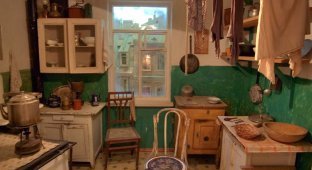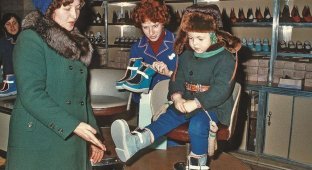Soviet furniture (25 photos)
When it comes to Soviet furniture, you most often hear 3 things:
“The USSR never had its own furniture. It was brought from the GDR, Hungary, Czechoslovakia, etc.”
"She was terrible to look at."
“She was quality.”
Each of these statements can be argued. But we don't want to do this. Let's just plunge into the atmosphere of past years, look at the photos and remember what it really was (yes, yes, it was) - Soviet furniture.

How did the production of household goods develop in the USSR? In what styles was Soviet furniture made? Let's look at these questions further.
Let's start with the fact that in pre-revolutionary Russia, furniture was produced mainly by hand or in a semi-handicraft way. Furniture factories were concentrated near St. Petersburg, Moscow, Riga, Kyiv and some other cities.

Under the USSR, industry began to gain momentum, and by 1940 the country already had many specialized enterprises in Moscow, Kharkov, Taganrog, Makhachkala, Gomel, Simferopol and other cities. They mass-produced simple and cheap furniture for the general population, as well as higher quality and “chic” products for new hotel and administrative buildings.
During the Great Patriotic War, factories, for the most part, were focused on producing a variety of goods for the front. Afterwards they were reorganized into sawmills and wood processing factories. It became possible to talk about the development of the quality and design of Soviet furniture only towards the end of the 1950s. But let's see what happened before that.

Soviet furniture in the 30-50s
The most suitable way to describe Soviet furniture of those times is the Empire style, or more precisely the “Stalinist Empire” style, combining Baroque, the imperial style of the era of Napoleon I and late classicism. Its main characteristics are some pomp and monumentality.

Thus, Soviet furniture was made of solid wood (often oak), had very impressive dimensions and, judging by its appearance, was capable of standing for 100 years. The wooden parts were decorated with elaborate carvings. Bright and patterned textiles were chosen for upholstered furniture. To complete the decoration, the interior was complemented by stucco, carpets, bronze lamps, painted ceramics and crystal (of course, in the homes of those who could afford it).

Among the most memorable models of Soviet furniture of the 30-50s, it is worth noting sofas with a shelf and a mirror, massive cupboards for dishes and turnkey wardrobes with two departments (for folding clothes and hangers).


However, the “Stalinist Empire style” was not destined to be improved or developed in any way. At the end of 1955, the USSR signed the Decree “On the elimination of excesses in design and construction.” Thanks to this, Soviet furniture in the minimalist style came onto the scene.

The influence of the “thaw” on Soviet furniture
The next period, in which a new direction of Soviet furniture design was formed, occurred at the end of the 1950s and continued until the end of the 1970s. It was also called the period of the “Khrushchev Thaw”.
In 1957, the furniture industry of the USSR experienced its rebirth thanks to the signing of a decree on accelerating the pace of housing construction. His task was to provide apartments to as many people as possible in a short time. Therefore, these apartments (known as “Khrushchevkas”) were made very small and with low ceilings, in contrast to the same spacious “Stalinka” apartments. Accordingly, in such conditions, massive Soviet furniture of the 30-50s could no longer be in great demand. This was another reason why, at that time, USSR designers completely embraced minimalism.

The main emphasis began to be placed on the production of furniture sets, rather than individual pieces of furniture. Such sets were developed specifically for 1-, 2- and 3-room apartments. At the same time, much attention was paid to convenience: the required configuration of a table, chair or cabinet was carefully calculated based on the average human height. To reduce the cost of furniture, chipboard, plywood and polymer materials began to be widely used. Efficient varnishing processes were also introduced into production.
[img]https://cn15.nevsedoma.com.ua/photo/686/152_files/sov
etskaya-mebel-60-e.jpg[/img]


Among the new types of furniture, it is worth noting a chair-bed, a sofa bed, simple low walls with or without legs, folding tables and kitchen sets.





It is interesting that many products released in the USSR at that time were not inferior in quality and design to similar foreign models. Upholstered furniture, kitchen, living room and children's sets, despite their ascetic character and minimalism, looked very stylish and in their aesthetics were no worse, for example, than the same Danish and American products.


Soviet furniture in the 80s and before the collapse of the USSR
Unfortunately, little good can be said about Soviet furniture after the early 80s. Aesthetics began to change rapidly and not for the better. So, for decorating the living room, they began to offer only the same type of “slides”. But even those were not particularly pleasing with their gloomy dark color, heavily polished surface that had to be constantly wiped, or chipping pieces of plywood covering.



As for the quality, it also began to gradually deteriorate. The legs and corners of the furniture began to deteriorate faster due to the use of low-quality plywood, metal and plastic fittings quickly became loose and, in general, the furniture design left much to be desired

It is precisely this type of furniture that everyone is rapidly trying to get rid of today. But as for the more “ancient” products from the 50s and 60s, we advise you to think carefully before throwing a Soviet bookcase (shelf, table, etc.) from those years into the street.



























